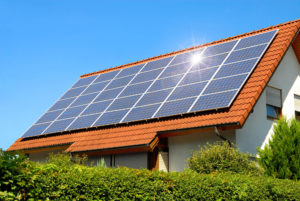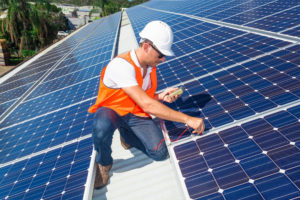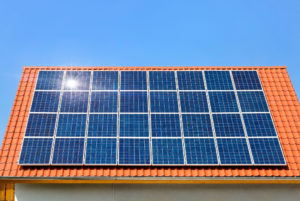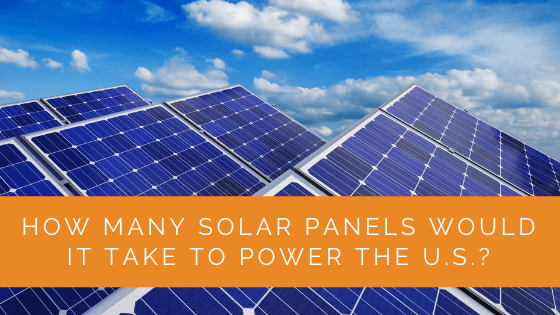Imagine a future where the entire United States is powered solely by the sun. This ambitious vision is not just a dream but a tangible possibility that hinges on one critical question: How many solar panels would it take to power the U.S.? This article delves into this monumental task’s intricate calculations and technological considerations. We explore the nitty-gritty of solar energy measurements, from watts to kilowatt-hours, and the colossal scale of solar farms required to meet the nation’s energy demands.
With insights from industry giants like Elon Musk and data from the U.S. Energy Information Administration, we paint a detailed picture of the current solar energy landscape and its potential to revolutionize how we power our country. This journey into the world of solar energy is not just about numbers and calculations; it’s a glimpse into a future where sustainable energy is not just a choice but a necessity. Join us as we unravel the fascinating intricacies of powering a nation with our solar system’s most abundant energy source.
Contents
- 1 Key Takeaway
- 2 The Intricate Solar Panel Measurements – How Many Square Miles?
- 3 Claims Made by Elon Musk – Is it Enough Solar Panels for the U.S.?
- 4 Can the U.S. Purely Rely on Solar Energy?
- 5 Solar Panel Installation Capacity to Power the Country
- 6 The Square Miles Required to Install Solar Panels in the USA
- 7 Expert Insights From Our Solar Panel Installers About How Many Solar Panels Would it Take to Power the U.S.
- 8 Experience Solar Excellence with Us!
- 9 Final Words
Key Takeaway
- The U.S. would ideally require approximately 7.86 billion solar panels to power the entire country with solar energy, consuming 12,000 kWh per year.
- Elon Musk proposed that a specific area in Texas covered in effective solar panels could power the entire U.S., based on sunlight capture and efficiency calculations.
- To power the U.S. solely with solar energy, it would require around 10,000 square miles of solar panel transmission, with a combination of rooftop and land solar panels, contributing to a sustainable electricity future.
The Intricate Solar Panel Measurements – How Many Square Miles?
How many solar panels would you require in square miles to power the entire U.S. with solar energy? The answer to that question will have huge data and would require optimal research.
But first, you should understand the measurement data before you read the entire article:
- Power gets measured in Watts (W)
- 1,000W is 1 Kilowatt (K.W.)
- The quantity of power consumption and the period = energy usage
- It has a measurement of Kilowatt-Hours (kWh) – It represents 1KW per hour.
Have you heard of the largest solar farm in the U.S.? It produces 579MW of solar energy. Anything of that magnitude will require optimal funding and resources.
From here, you can understand the billions of dollars required per year to maintain efficiency in every square mile of solar panels.
Claims Made by Elon Musk – Is it Enough Solar Panels for the U.S.?
During Elon Musk’s launch of the Tesla PowerPack batteries and PowerWall, he showcased the surface area of the U.S. He marked a small Nort-West corner located in Texas.
Elon Musk said that if he installed effective solar panels on that surface area, it would be enough to power U.S. electricity and enable a carbon-free environment.
This assumption of solar P.V. generation for the U.S. was based on the multiplication of the surface area with the P.V. efficiency. It means the amount of sunlight captured and the amount of solar P.V. per unit area.

The Map By Elon Musk
It takes 425 GW on average to power the U.S. Therefore, according to the EIA, that is 3725 TWh per year!
The map shown by Elon Musk has a 10,000 km2 area that requires many solar panels. Moreover, in North-West Texas, the solar P.V. yield is 21%, and the highest efficiency from solar panels in the U.S. is 24%.
It translates to 0.24 GW per km2 as measured standardly under the sun.
If you calculate everything together, you will get a solar energy generation of 500 GW, which is greater than 425 GW.
Indeed, if Elon Musk wants to install enough solar panels to generate enough power, he would need a proper visualization of this surface area.
Therefore, the surface area shown on his map can cover the entire U.S. electricity consumption and account for resistance losses.
Can the U.S. Purely Rely on Solar Energy?
If we consider the drastic changes to the earth’s climate, everyone would be curious to know how many solar panels would it take to power a country like the U.S.?
There is a 1NW solar farm in the U.S. that houses 5040 solar panels. This many solar panels can generate 195W to 200W. Moreover, you will see 4.8 acres of solar panels in this area.
It produces around 1.7 million kilowatt-hours every year!
On average, this farm can power itself with 5 to 6 hours of sunlight consumption. Due to this, it can generate solar energy with efficiency.
To electrify the world, you will need 92.7 billion solar panels through 84,531 square miles of space.
The Land Requirements
According to the IEA, the U.S. consumes 4,476 TWh and requires 3.5 TW (or 3.5 hours) of photovoltaic power per day.
You will require 7 to 10 billion 350W solar panels on average to generate enough power for the country.
Furthermore, if you consider surface area, you will need 21,913 square miles of solar power transmission to power the U.S.!
Indeed, we can power the entire U.S. with this amount of solar panels. However, powering the world can be a bit tricky in terms of kilowatt-hours.
Solar Panel Installation Capacity to Power the Country
As per the current solar panels’ infrastructure, the nation can produce 4000 billion kWh yearly. Therefore, it is a daily average of electricity production from solar power of 11 billion kWh.
If you want to power the entire U.S., it will take some calculations.
If you divide this number by the hourly energy consumption, you will get hourly data.
However, solar power cannot operate 24/7, which means the kWh per hour and the electricity generation cannot be the same.

The Capacity
If you need 24 kWh of solar power every day, the hourly consumption will be 1 kW. Such a solar panel would not have much solar power to generate 24-hour energy based on the day-night cycle.
Therefore, solar power generation is directly proportionate to the square miles of sunlight the solar panels get.
It means that the peak sunlight will determine how much solar power gets absorbed and electricity is produced.
Industrial solar panels work the same way as rooftop solar panels. So, the energy generation will be dependent on the sun. Moreover, 100% sunshine will only last from 3.5 to 5.5 hours in the USA.
The sunlight in Arizona will not be similar to that of Seattle.
You would need more than a billion solar panels to harness the average solar power of 4 hours. However, the answer still depends on the latitude where the solar panel gets installed.
The Average Calculation to Power the U.S.
If you divide the 4000 billion kWh with 4 hours of full generation, you will get 2,750 million K.W. (2.75 TW). Moreover, a large-sized solar panel can produce 350W of energy.
If you consider this rating, the consumption would be 2.75 TW divided by 350W.
Therefore, in the USA, you will require 7.85 billion solar panels with the efficient capacity to generate electricity per KWh for every household.
The Square Miles Required to Install Solar Panels in the USA
Indeed, you do not need to install solar panels all around the U.S. to produce solar power and facilitate sustainable electricity. Moreover, it would be an issue to install such panels at a single location.
One thing that can solve this issue is by cumulative installation throughout the country in different states.
To produce a megawatt, it would take 5 acres of land. Therefore, for the 2.75 TW, it will need an average of 13,750,000 acres to produce effective electricity.
You cannot install all types of solar panels on vast acres of land. Indeed, rooftop solar plants have become famous and sufficient for any space.
The U.S. consumes four petawatt hours every year for electricity.
Hence, the approximate 21,250 square miles is perfect to meet this requirement from solar power!
Is 21,000 Square Miles Enough for the Entire U.S.?
The U.S. has 3,797,000 square miles. Compared to that, the 21,250 square miles do not seem like a large number. Moreover, it will require half of the total area to power the USA!
Even so, according to a report, we would require 10,000 square miles of effective solar panel transmission.
Why is that?
It is because of the 34% contribution of solar electric energy from the rooftop space.
Modern solar panels have a 16% to 20% efficiency which means a smaller space can also make the transmission work.
Therefore, with rooftop and land solar panels, the dream of sustainable electricity can be achieved with the highest capacity.
On average, the electric power generated from solar-powered energy accounts for 2% of households. But, with the future of clean energy so bright, Elon Musk’s dream can come true!

Expert Insights From Our Solar Panel Installers About How Many Solar Panels Would it Take to Power the U.S.
Powering the entire U.S. with solar panels is a colossal task, but it’s within reach. The technology and efficiency of modern solar panels make it feasible to generate enough electricity to meet national demands.
Senior Solar Installer
The idea that a relatively small area in Texas could power the entire country is fascinating. It highlights the immense potential of solar energy and the importance of strategic placement and efficiency in solar panel installations.
Lead Solar Technician
Understanding the scale of solar panel installations needed for the U.S. underscores the importance of innovation and investment in renewable energy. Solar energy offers a sustainable and scalable solution to our energy needs.
Solar Installation Manager
Experience Solar Excellence with Us!
Trust in Solar Panels Network USA, where our seasoned experts deliver top-quality solar solutions for homes and businesses nationwide. With a legacy of countless successful installations and a commitment to sustainable energy, we’re your reliable partner in the solar journey. Ready for a brighter, eco-friendly future? Call us now at (855) 427-0058 and harness the power of the sun!
Final Words
The cost of installing solar panels will not burn a hole in the economy. Instead, it will enhance sustainable power and energy generation. How much solar is too much solar?
Ideally, the USA would need 7.86 billion solar panels on land that gets efficient hours of sunlight. Only then can the number of solar panels produce enough electric energy.
Moreover, the cost of solar batteries has declined, and solar plants have increased.
That alone should be your answer to the sustainable alternative to producing electricity in the U.S. Furthermore, solar power storage is easy, and small installations can work towards a big change.
Indeed, solar power is worth it and can change the world!
About the Author
Solar Panels Network USA stands at the forefront of solar energy solutions, driven by a team of seasoned solar engineers and energy consultants. With over decades of experience in delivering high-quality solar installations and maintenance, we are committed to promoting sustainable energy through customer-centric, tailored solutions. Our articles reflect this commitment, crafted collaboratively by experts to provide accurate, up-to-date insights into solar technology, ensuring our readers are well-informed and empowered in their solar energy decisions.

